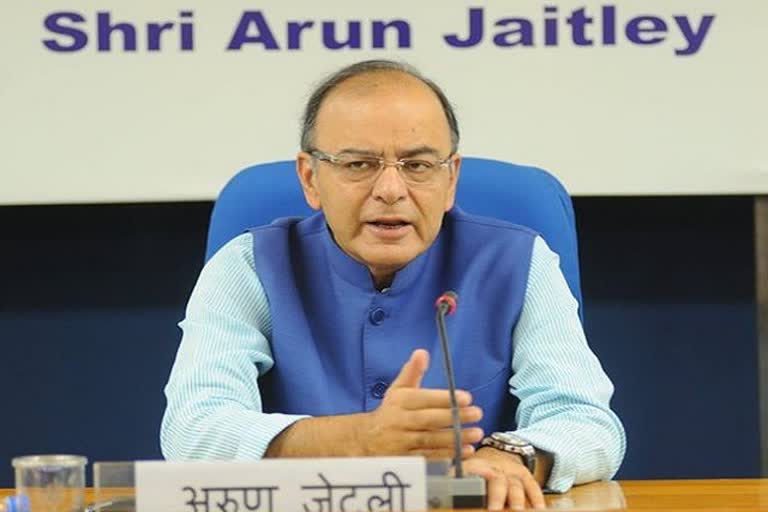New Delhi: The Finance Ministry on Monday said GST has reduced the rate at which people have to pay tax, helped increase compliance and doubled taxpayer base to 1.24 crore.
In a series of tweets, on the first death anniversary of former Finance Minister Arun Jaitley, the ministry said before goods and services tax (GST), the combination of value-added tax (VAT), excise, sales tax and their cascading effect resulted in high standard rate of tax up to 31 per cent.
It is now widely acknowledged that GST is both consumer and taxpayer-friendly. While the high tax rates of the pre-GST era acted as a disincentive to paying tax, the lower rates under GST helped to increase tax compliance, the ministry said.
The number of assessees covered by the GST at the time of its inception were about 65 lakh. Now the assessee base exceeds 1.24 crore.
GST, which subsumed about 17 local levies, was rolled out on July 1, 2017. Jaitley held the finance portfolio in the first term of the Modi government since 2014.
As we remember Arun Jaitley today, let us acknowledge the key role he played in the implementation of GST, which will go down in history as one of the most fundamental landmark reforms in Indian taxation, the Ministry tweeted.
-
As we remember Shri Arun Jaitley today, let us acknowledge the key role he played in the implementation of GST, which will go down in history as one of the most fundamental landmark reforms in Indian taxation. (2/6)
— Ministry of Finance (@FinMinIndia) August 24, 2020 " class="align-text-top noRightClick twitterSection" data="
">As we remember Shri Arun Jaitley today, let us acknowledge the key role he played in the implementation of GST, which will go down in history as one of the most fundamental landmark reforms in Indian taxation. (2/6)
— Ministry of Finance (@FinMinIndia) August 24, 2020As we remember Shri Arun Jaitley today, let us acknowledge the key role he played in the implementation of GST, which will go down in history as one of the most fundamental landmark reforms in Indian taxation. (2/6)
— Ministry of Finance (@FinMinIndia) August 24, 2020
The multiple markets across India, with each state charging a different rate of tax, led to huge inefficiencies and costs of compliance.
-
The multiple markets across India, with each state charging a different rate of tax, led to huge inefficiencies and costs of compliance. Under GST, compliance has been improving steadily. Taxpayer base has almost doubled to 1.24 crore. (4/6) pic.twitter.com/3CcmaFJyeK
— Ministry of Finance (@FinMinIndia) August 24, 2020 " class="align-text-top noRightClick twitterSection" data="
">The multiple markets across India, with each state charging a different rate of tax, led to huge inefficiencies and costs of compliance. Under GST, compliance has been improving steadily. Taxpayer base has almost doubled to 1.24 crore. (4/6) pic.twitter.com/3CcmaFJyeK
— Ministry of Finance (@FinMinIndia) August 24, 2020The multiple markets across India, with each state charging a different rate of tax, led to huge inefficiencies and costs of compliance. Under GST, compliance has been improving steadily. Taxpayer base has almost doubled to 1.24 crore. (4/6) pic.twitter.com/3CcmaFJyeK
— Ministry of Finance (@FinMinIndia) August 24, 2020
GST has reduced the rate at which people have to pay tax. The revenue neutral rate as per the RNR (Revenue Neutral Rate) Committee was 15.3 per cent. Compared to this, the weighted GST rate at present, according to the RBI, is only 11.6 per cent, the ministry said.
-
It is now widely acknowledged that GST is both consumer and taxpayer-friendly. While the high tax rates of the pre-GST era acted as a disincentive to paying tax, the lower rates under GST helped to increase tax compliance. (6/6)
— Ministry of Finance (@FinMinIndia) August 24, 2020 " class="align-text-top noRightClick twitterSection" data="
">It is now widely acknowledged that GST is both consumer and taxpayer-friendly. While the high tax rates of the pre-GST era acted as a disincentive to paying tax, the lower rates under GST helped to increase tax compliance. (6/6)
— Ministry of Finance (@FinMinIndia) August 24, 2020It is now widely acknowledged that GST is both consumer and taxpayer-friendly. While the high tax rates of the pre-GST era acted as a disincentive to paying tax, the lower rates under GST helped to increase tax compliance. (6/6)
— Ministry of Finance (@FinMinIndia) August 24, 2020
Read more:Businesses to get GST registration within 3 days with Aadhaar authentication
Businesses with an annual turnover of up to Rs 40 lakh are GST exempt. Initially, this limit was Rs 20 lakh. Additionally, those with a turnover up to Rs 1.5 crore can opt for the Composition Scheme and pay only 1 per cent tax.
Once GST was implemented, the tax rate on a large number of items was brought down. As of now, the 28 per cent rate is almost solely restricted to sin and luxury items. Out of a total of about 230 items in the 28 per cent slab, about 200 items have been shifted to lower slabs, the ministry said.
Also, the housing sector has been placed in the 5 per cent slab, while GST on affordable housing has been reduced to 1 per cent.
All processes in GST have been fully automated. Till now 50 crore returns have been filed online and 131 crore e-way bill generated, the Ministry added.
(PTI Report)



